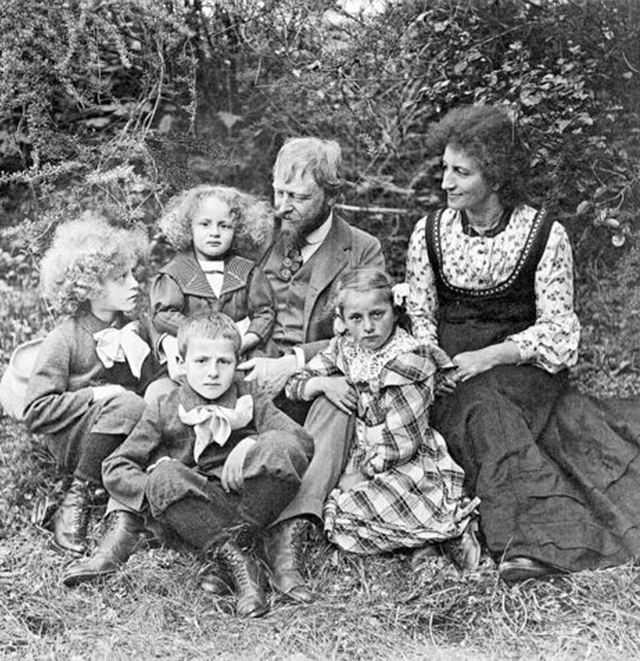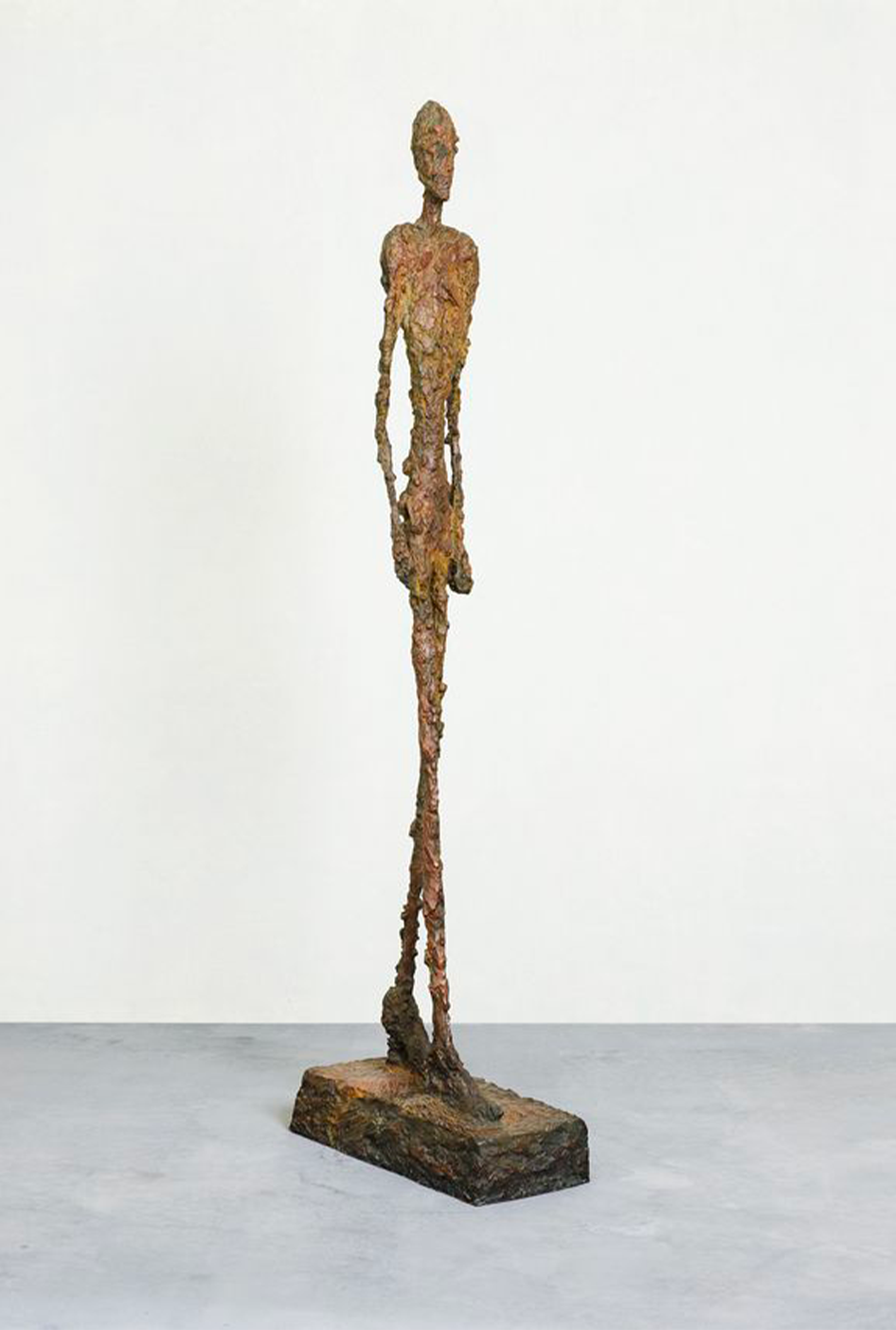Appearing with his iconic Walking Man on the old 100 Swiss franc bills, this Swiss-born artist has been switching and reinventing artistic codes throughout the evolution of his vision. While his creations veer towards classicism, cubism, surrealism or even his own filiform touch, only one thing remains: his envy for the human head and body. This is the biography of the Helvetian who knew how to capture the fragility of the ephemeral in his stretched silhouettes.
If the name Giacometti is mostly associated with Alberto, it is a real clan of artists that is revealed behind these 10 letters. A creative epicenter of Borgonovo in the Bregaglia Valley where the future sculptor got his start! First of all, there is the father, Giovanni, one of the best known representatives of Swiss post-impressionism. Born in 1868 in Stampa, he spent some years in Germany, France and Italy before returning to Graubünden and marrying Annetta Stampa. Then came the three brothers and their only sister. Alberto was born in 1901, Diego the following year, Ottilia in 1904 and the youngest, Bruno, in 1907. The two eldest brothers, both painters and sculptors, would go through life elbow to elbow, working together in their Parisian studio. The only difference was that Alberto was fascinated by man, while his younger brother was fond of the animal kingdom. As Ferdinand Hodler’s godson, Diego was to be the unwavering pillar of support throughout his brother’s life. The only daughter of the siblings would not be an artist herself, but would become their very patient model, able to pose for hours on end. And what a hardship that could be! Moreover, his son, Silvio Berthoud, will also play the game for his illustrious uncle! But that’s another story. Finally, the youngest of the clan, Bruno, will also follow the path of creativity, but will work in architecture.


The one who will become THE Giacometti
His father creates constantly in the workshop-garage of the family house. His godfather, the symbolist painter Cuno Amiet, showed him his technique. His uncle, Augusto Giacometti, experimented with ornamental art. His parents’ artist friends regularly visited the family in Stampa. In this atmosphere of creativity and artistic exchange, Alberto Giacometti had no choice but to enter this machine of self-expression. Lulled by the landscapes of Graubünden and the beauty of the rugged nature of his native region, he began his career as a painter and sculptor at an early age. His virtuosity is already noticeable at an early age. Just looking at his Still Life with Apples or the first head of his brother Diego’s Head on a Pedestal (and how many others there will be!), made around 1915, what a talent! At that time, the style of the young prodigy was greatly influenced by what he saw most, the work of his fathers, but his determination was concrete: he wanted to be an artist! The only question that remains is: painter or sculptor? Much later, in 1963, the artist will say: “I started with sculpture, because it is precisely the field that I understood the least.
From Switzerland to France and vice versa


This is the beginning of his long journey in creative search, far from the turquoise lakes and rocky peaks. Alberto Giacometti first went to Geneva to study at the École des Beaux-Arts. Although this first stay was quite brief, the painter will still have the opportunity to discover the Cathedral of St. Peter up close. But let’s not go too quickly. It was 1920 and Alberto accompanied his father to the Venice Biennale. During this trip to Italy, which would last almost a year, the young man would appropriate the heritage of Rome, discovering in particular the Italian primitives. After this adventure, the sculptor decided to settle in Paris in 1922, to join the Académie de la Grande Chaumière. In the end, he would only attend occasionally. Quickly joined by his brother Diego, the two freshly Parisian representatives of the Giacometti clan settled in the 14th arrondissement. A 20 square meter first floor apartment at 46, rue Hippolyte-Maindron. La Grotte, as the artist fondly called it, would be his home and studio, as cramped as it was intimate, until the end of his life. A period of discovery of the arts and experimentation with materials began for the young Swiss. From one encounter to another, his aesthetic inclinations evolved. Like his predecessors, he first became interested in primitive art. Drawing his inspiration from African sculptures, the young Alberto produced a whole series of flat heads and bodies with cubic aspirations. The line is still smooth and the shapes are rounded, but the portraits and silhouettes begin to stretch in the hands of the master. Moreover, it is also with these works that the Swiss will present himself to the French public, at the Salon des Tuileries. And will venture into surrealism immediately. His Tête qui regarde (Head Looking) aroused the interest of the group led by André Breton in 1929, while the Boule suspendue (Suspended Ball) of 1930 confirmed this new direction for Giacometti. With his creations of absurd objects, without utility and with symbolic function, he officially joined the movement in 1931 and will be one of the only sculptors. Paradoxically, it was also a head that led to his exclusion from the group in 1935. And not just one! Fascinated by this part of the human body and the mysteries hidden in the eyes, the sculptor resumed his research on models. This quest for the representation of reality is in contradiction with the very principle of this movement. The choice will be quickly made! While his surrealist works attract attention at numerous exhibitions, the artist wants to sculpt it in stone and wood. The death of his sister in childbirth in 1937 and the outbreak of World War II prompted Alberto Giacometti to return to Geneva, where he found his mother and his only godson, Silvio.
The abyss of the tiny

©Succession Giacometti (Fondation Giacometti, Paris et ADAGP, Paris)
The years 1935 to 1946 were a pivotal period for the artist. The most extensive and profound in his creative process, this crisis is a radical questioning of his vision. The rapid succession of movements led to the loss of his own identity. Through this introspection and artistic evolution, the sculptor wants to free himself from his codes to represent only reality. In his way of perceiving the world, he represents the models as he sees them, from a distance. An intuitive reflex that will gradually reduce the size of his sculptures. “A large figure was false to me and a small one was intolerable, and then they became so tiny that often with a final stroke of the knife they disappeared into the dust,” he said. The anecdote wants that he walks in the streets of Geneva with his statuettes in a matchbox. Only the tiny figurines placed on huge pedestals, sometimes several times their own size, would survive the methodical destruction of the artist, dissatisfied with his work. Finally, Alberto Giacometti managed to break this Lilliputian process with the creation of Woman with a Cart in 1945. Freed from the inverted magnifying glass effect, the artist returned to Paris. But his style will be transformed forever. If his figures gain in height, they remain thin, almost ghostly, with stretched and filiform bodies and faces. “I never voluntarily wanted to make elongated or thin sculptures! I always wanted to make them as close as possible to what I saw. In spite of myself, completely in spite of myself, they became elongated, as if they were tiny. They only became real when they were tiny or elongated. I fought against this elongation for years…” Alberto Giacometti explained to the press. From this quest, a unique representation of fragility with features reduced to the essential was born. The 1950s were extremely fruitful for the artist, who produced works that would become his calling card through the ages… and would rank in the top lines of the most expensive sculptures in history. Walking Man I sold for over 100 million dollars in 2010 or Man with Finger for over 140, five years later, to name a few.
This new way of seeing sculpture attracts the public. Exhibitions and retrospectives multiply in the most important museums in the world. The most symbolic is surely his participation in the Venice Biennale of 1962. The circle is closed.
But his health deteriorated. If Annette, his wife since 1949, and his brother Diego were his faces throughout his life, Giacometti’s last model was the filmmaker and photographer, Eli Lotar. The sculptor of narrow silhouettes died on January 11, 1966, leaving behind him an immense legacy of bronzes, plasters, paintings and prints. But if the creator is no more, the Man continues his march.


